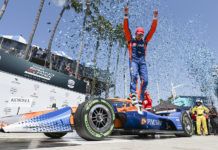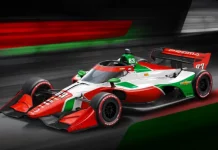Reigning Verizon IndyCar Series champion Will Power kicked off the “aero era” by recording the quickest lap time in today’s initial practice session for the season-opening Firestone Grand Prix of St. Petersburg.
Power’s lap of 1 minute, 1.4709 seconds in the No. 1 Verizon Team Penske Chevrolet breezed past the 2014 Verizon P1 Award-winning lap of 1:01.8668 produced by Takuma Sato on the 1.8-mile temporary street circuit.
Power was among five drivers, including Team Penske teammates Juan Pablo Montoya (1:01.6996) and Helio Castroneves (1:01.7000), to better last year’s pole time, even without the Firestone Firehawk alternate tires that they’ll be allowed to use in the three rounds of Saturday qualifications.
As a steady rain fell through the afternoon, no drivers turned laps in the companion session. Another practice session is scheduled for 12:30 p.m. ET Saturday preceding qualifications for the 110-lap race Sunday (3 p.m. ET, ABC).
Last year at St. Petersburg, James Hinchcliffe’s lap of 1:02.9326 topped the first session.
“It was pretty straightforward for us. I think it’s just understanding last year’s mechanical balance of the car with the new aero stuff and just going through basic changes to see what they do,” said Power, who won the season-opening race in March 2014 and earned the St. Petersburg pole four straight years from 2010-13.
“The kits produce massive downforce, low drag and the cars are absolutely glued to the track. Obviously, as we go along in the year we are going to learn more and more about what we need to push for wins.”
Scott Dixon (1:01.7777) and Sebastien Bourdais (1:01.8439) also were quicker around the circuit than the 2014 pole time using the Chevrolet aero/engine package. Second-year driver Jack Hawksworth (1:01.8713) was quickest of the 12 Honda drivers.
Bourdais’ track record of 1:00.928 (106.710 mph) set in qualifying for the inaugural Indy car race in 2003 could come under assault.
Both manufacturers developed aerodynamic bodywork platforms for street/road course and short ovals along with a speedway package under INDYCAR regulations. The Chevrolet and Honda aero kits also look distinctly different.
There are multiple combinations of components that crews can utilize to tailor the package to suit drivers and a particular racetrack to optimize performance. They’ve had two weeks of on-track testing available to decipher the characteristics of the road/street and short oval package. The speedway aero kits are scheduled to be delivered to teams April 1 and make their competitive debut at the Indianapolis 500.
“There’s a noticeable speed increase from last year and that’s from downforce without a lot of drag penalty,” said CFH Racing driver Josef Newgarden, who was 10th on the time chart. “They’re very efficient packages and Chevrolet and Honda have spent millions of dollars into making the best aerodynamic pieces that they can.
“Everything on the car is lot more refined and it’s just faster. That’s the big difference in plain terms.”
Added 2014 Indianapolis 500 winner and 2012 Verizon IndyCar Series champion Ryan Hunter-Reay: “Racing, first of all, is all about innovation and development and that’s what we have with the aero kits. The engine manufacturers have been tasked to put on as much downforce as efficiently as possible, and what you see is a complete transformation of this Indy car where Chevy has its own look and brand and Honda has its own look and brand and stamp on the car.
“The performance is up, track records will be broken this year, and they look like you need to wear protective gloves around them, so they look awesome. They look like they should, which is incredibly fast and somewhat scary.”
Press Release Indycar Media



















